Modeling HTS Coils With Different Coupling Scenarios via Integral Method
IF 1.7
3区 物理与天体物理
Q3 ENGINEERING, ELECTRICAL & ELECTRONIC
引用次数: 0
Abstract
High-temperature superconducting tapes can be stacked together to form cables which are then wound into coils for potential use in electrical machines. The tapes in the cable can either be uncoupled (insulated from each other), coupled at ends (coupled at the terminals of the cable), or fully coupled (electrically connected with each other along the whole length of the cable). The integral method can readily model the uncoupled scenario, and this article extends the integral method to model the coupled-at-ends and fully coupled scenarios. We find that the proposed method has a time advantage over the well-established通过积分法为不同耦合情况下的 HTS 线圈建模
高温超导带可以堆叠在一起形成电缆,然后绕成线圈,可能用于电机。电缆中的磁带可以是非耦合的(相互绝缘)、两端耦合的(电缆终端耦合)或完全耦合的(电缆全长相互电连接)。积分法可轻松模拟非耦合情况,本文将积分法扩展到模拟两端耦合和完全耦合情况。我们发现,与麦克斯韦方程成熟的 T-A 公式相比,所提出的方法具有时间上的优势。
本文章由计算机程序翻译,如有差异,请以英文原文为准。
求助全文
约1分钟内获得全文
求助全文
来源期刊

IEEE Transactions on Applied Superconductivity
工程技术-工程:电子与电气
CiteScore
3.50
自引率
33.30%
发文量
650
审稿时长
2.3 months
期刊介绍:
IEEE Transactions on Applied Superconductivity (TAS) contains articles on the applications of superconductivity and other relevant technology. Electronic applications include analog and digital circuits employing thin films and active devices such as Josephson junctions. Large scale applications include magnets for power applications such as motors and generators, for magnetic resonance, for accelerators, and cable applications such as power transmission.
 求助内容:
求助内容: 应助结果提醒方式:
应助结果提醒方式:


